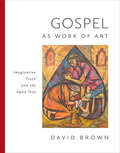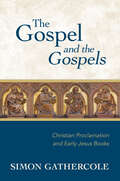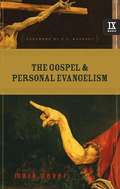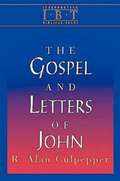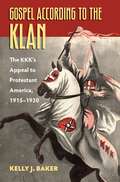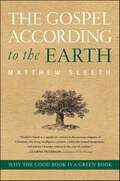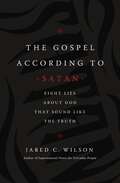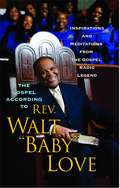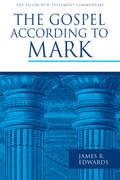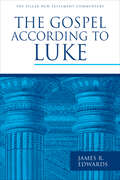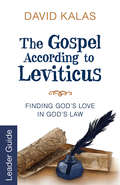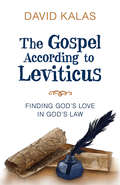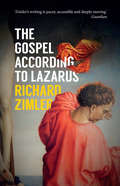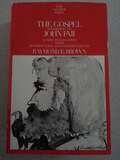- Table View
- List View
Gospel as Work of Art: Imaginative Truth and the Open Text
by David BrownA lushly illustrated, magisterial exploration of the imaginative truth of the gospel In the modern academy, truth and imagination are thought to be mutually exclusive. But what if truth can spring from other fonts, like art, literature, and invention? The legacy of the Enlightenment favors historical and empirical inquiry above all other methods for searching for truth. But this assumption stymies our theological explorations. Though the historicity of Jesus&’s life, death, and resurrection is important, it is not of sole importance. For instance, is John&’s Gospel any less &“true&” than the Synoptics just because it&’s less historically accurate? David Brown challenges us to expand our understanding of the gospel past source criticism and historical Jesus studies to include works of imagination. Reading Scripture in tandem with works of art throughout the centuries, Brown reenvisions the gospel as an open text. Scholars of theology and biblical studies, freed from literalism, will find new avenues of revelation in Gospel as Work of Art. This volume includes over one hundred color illustrations.
The Gospel and the Gospels: Christian Proclamation and Early Jesus Books (Baylor-mohr Siebeck Studies In Early Christianity Ser.)
by Simon J. GathercoleA robust scholarly defense of the distinctiveness of the canonical Gospels. Is there anything that makes the four New Testament Gospels different from other early Christian Gospels? The tendency among biblical scholars of late has been to declare the answer to this question no—that the Gospels of Matthew, Mark, Luke, and John were grouped together by happenstance and are defended as canonical today despite there being no essential commonalities between them. Simon Gathercole challenges this prevailing view and argues that there are in fact substantial differences of theological content between the New Testament Gospels and noncanonical Gospels. Gathercole shows how the Gospels of Matthew, Mark, Luke, and John each include four key points that also formed the core of early Christian preaching and teaching: Jesus&’s identity as messiah, the saving death of Jesus, the resurrection of Jesus, and Scripture&’s foretelling of the Christ event. In contrast, most noncanonical Gospels—like the Gospel of Thomas, the Gospel of Truth, and Marcion&’s Gospel—only selectively appropriated these central concerns of early Christian proclamation.
The Gospel and The Catholic Church
by Michael RamseyThe underlying conviction of this book is that the meaning of the Christian Church becomes most clear when it. is studied in terms of the Death and Resurrection of Jesus Christ. The author attempts to apply this conviction to some of the problems concerning the doctrine of the Church. What is the nature of Christian fellowship in contrast with other ideas of unity amongst men? Is Episcopacy merely a convenient form of Church govern¬ment, or has it some deeper meaning in the Gospel of God? These are among the questions which this book discusses, by expounding the Church as a part of the Gospel of Christ crucified.
The Gospel and Pluralism Today: Reassessing Lesslie Newbigin in the 21st Century (Missiological Engagements)
by Scott W. Sunquist Amos YongGospel in a Pluralist SocietyWilliam BurrowsJohn FlettVeli-Matti KärkkäinenEsther MeekWilbert Shenk
The Gospel and Personal Evangelism
by Mark E. DeverSeeks to encourage readers to understand the fundamentals of evangelism and to challenge them to develop a culture of evangelism in their lives and their local churches.
The Gospel and Letters of John, Volume 2: The Gospel of John (The Eerdmans Critical Commentary)
by Urban C. von WahldeUrban von Wahlde’s radically new, three-volume commentary on the Gospel and Letters of John is the most detailed study of the composition of the Johannine literature ever put forth by an American scholar. / Nearly all of the problems confronted by those who study John have to do with the literary strata of the Gospel of John and their relation to the composition of the Letters of John. With an archaeologist’s precision, and engaging a whole range of scholarly contributions in this area, von Wahlde digs down to the foundations and exposes three distinct literary strata in the development of the Johannine tradition. Volume 1 gives detailed evidence identifying and listing the criteria for each stratum. Volumes 2 and 3 apply those criteria to the Gospel and Letters of John respectively. / These books are part of the Eerdmans Critical Commentary series, edited by David Noel Freedman and Astrid B. Beck.
The Gospel and Letters of John, Volume 1: Introduction, Analysis, and Reference (The Eerdmans Critical Commentary)
by Urban C. von WahldeUrban von Wahlde’s radically new, three-volume commentary on the Gospel and Letters of John is the most detailed study of the composition of the Johannine literature ever put forth by an American scholar.Nearly all of the problems confronted by those who study John have to do with the literary strata of the Gospel of John and their relation to the composition of the Letters of John. With an archaeologist’s precision, and engaging a whole range of scholarly contributions in this area, von Wahlde digs down to the foundations and exposes three distinct literary strata in the development of the Johannine tradition. Volume 1 gives detailed evidence identifying and listing the criteria for each stratum. Volumes 2 and 3 apply those criteria to the Gospel and Letters of John respectively.
The Gospel and Letters of John: Interpreting Biblical Texts Series (Interpreting Biblical Texts)
by R. Alan CulpepperIn this volume, R. Alan Culpepper considers both the Gospel and the Letters of John. The book begins with a close look at the relationship between John and the Synoptics and a summary of John's distinctive thought and language. The second chapter addresses the fascinating issues regarding the origins of the Gospel and the letters: authorship, sources, and composition. The history of the Johannine community is reviewed in chapter three. Chapter four interprets the plot of the Gospel and prepares the student to read John as literature by providing a brief orientation to narrative criticism. The fifth chapter turns to more traditional concerns: John as theology. This chapter provides a digest of the Christology, theology, and eschatology of John. The sixth through the eighth chapters, the heart of the book, guide the student through a reading of the Gospel. The ninth chapter serves as an introduction to the Letters, noting especially their relationship to the Gospel. Each letter is treated in turn. The final chapter examines the challenges and potential of the Johannine literature as documents of faith. "In previous writings Alan Culpepper has shown himself to be one of the best Johannine scholars of our time. He not only conveniently draws together his research but also shows himself to be an excellent teacher." --Raymond E. Brown
The Gospel According to the Son
by Norman MailerNorman Mailer fused fact and fiction to create indelible portraits of such figures as Marilyn Monroe, Gary Gilmore, and Lee Harvey Oswald. In The Gospel According to the Son, Mailer reimagines, as no other modern author has, the key character of Western history. Here is Jesus Christ's story in his own words: the discovery of his divinity and the painful, powerful journey to accepting and expressing it, "as if I were a man enclosing another man within." In its brevity and piercing simplicity, it may be Mailer's most accessible, direct, and heartfelt work.
Gospel According to the Klan: The KKK's Appeal to Protestant America, 1915-1930
by Kelly J. BakerTo many Americans, modern marches by the Ku Klux Klan may seem like a throwback to the past or posturing by bigoted hatemongers. To Kelly Baker, they are a reminder of how deeply the Klan is rooted in American mainstream Protestant culture. Most studies of the KKK dismiss it as an organization of racists attempting to intimidate minorities and argue that the Klan used religion only as a rhetorical device. Baker contends instead that the KKK based its justifications for hatred on a particular brand of Protestantism that resonated with mainstream Americans, one that employed burning crosses and robes to explicitly exclude Jews and Catholics. To show how the Klan used religion to further its agenda of hate while appealing to everyday Americans, Kelly Baker takes readers back to its "second incarnation" in the 1920s. During that decade, the revived Klan hired a public relations firm that suggested it could reach a wider audience by presenting itself as a "fraternal Protestant organization that championed white supremacy as opposed to marauders of the night." That campaign was so successful that the Klan established chapters in all forty-eight states. Baker has scoured official newspapers and magazines issued by the Klan during that era to reveal the inner workings of the order and show how its leadership manipulated religion, nationalism, gender, and race. Through these publications we see a Klan trying to adapt its hate-based positions with the changing times in order to expand its base by reaching beyond a narrowly defined white male Protestant America. This engrossing expos looks closely at the Klan's definition of Protestantism, its belief in a strong relationship between church and state, its notions of masculinity and femininity, and its views on Jews and African Americans. The book also examines in detail the Klan's infamous 1924 anti-Catholic riot at Notre Dame University and draws alarming parallels between the Klan's message of the 1920s and current posturing by some Tea Party members and their sympathizers. Analyzing the complex religious arguments the Klan crafted to gain acceptability--and credibility--among angry Americans, Baker reveals that the Klan was more successful at crafting this message than has been credited by historians. To tell American history from this startling perspective demonstrates that some citizens still participate in intolerant behavior to protect a fabled white Protestant nation.
The Gospel According to the Earth: Why the Good Book Is a Green Book
by Matthew Sleeth“Matthew Sleeth is a significant convert in the growing company of Christians who bring intelligence, passion, a biblically trained imagination, and mature Christian witness to the care of creation.” — Eugene Peterson, Author of Living the Message“Matthew Sleeth is a breath of fresh air. In The Gospel According to the Earth, he retells the Bible’s most familiar stories in ways that will stimulate your imagination, soften your heart, and challenge you to think more deeply about caring for creation.” Jonathan Merritt, author of Green Like God From Dr. Matthew Sleeth, the leading Christian voice for the green movement, comes a dynamic and surprising primer on all the Bible teaches on caring for the earth— and an ideal companion volume to The Green Bible.
The Gospel According to the Apostles: The Roll of Works in a Life of Faith
by John MacarthurEver since the days of the apostles Paul and James, Christians have struggled to define the proper tension between faith and works. Salvation, Paul stresses is "not by works, so that no one can boast" (Ephesians 2:8-9). But James argues, "Show me your faith without your works, and I will show you my faith by my works" (2:18).In his characteristic compelling style Dr. MacArthur reconciles these two seemingly divergent threads of biblical truth, taking on the difficult questions head on:What is cheap grace?Have some Christians adopted a "no-lordship" theology?What must a person do to be considered righteous by God?Do our works have any affect on our salvation?Jesus asked his followers, "Why do you call me Lord and not do the things that I tell you to?" When John MacArthur dared in his earlier book to ask us this question, critics accused him of shelving grace. Others read the same book and heard in it the identical message preached since the founding of the Church."The Gospel According to the Apostles is the same gospel Jesus preached," Dr. MacArthur says, "but it differs dramatically from the diluted message popular today. I pray you'll find this book an encouragement as you seek to put your own faith to work."
The Gospel According to Starbucks: Living with a Grande Passion
by Leonard SweetSweet guides readers from the coffee shop right to the heart of God in this handbook that reveals unexpected spiritual lessons discovered at the local Starbucks.
The Gospel According to Satan: Eight Lies about God that Sound Like the Truth
by Jared C. WilsonNot every lie sounds untrue.Some lies are repeated so often they seem to be common sense. That's why lies about God are so dangerous. The Gospel According to Satan examines eight lies the enemy wants us to believe and provides eight lines of counterattack against them. The lies include:God just wants you to be happy;you only live onceyou need to live your truth; andjust let go and let God.Jared C. Wilson reveals why these lies appeal to us, shows how they harm us, and provides ways to counteract them. We can renounce Satan's counterfeit gospel, but first we must see it for what it is. "Enumerates the major ways the Devil uses his cunning and calculating ways of luring us off the narrow road of God's grace. We will all do well to read this book and confront the lies we are being sold."--Kyle Idleman, senior pastor of Southeast Christian Church and author of Not a Fan and Don&’t Give Up"A unique, compelling, and even witty look at the devil's current greatest hits--lies we urgently need to unmask." --Sam Allberry, speaker for Ravi Zacharias International Ministries and author of 7 Myths About Singleness and Why Does God Care Who I Sleep With? "One of the most thought-provoking writers in the Christian world today... He doesn&’t just describe the tantalizing falsehoods of our age, he exposes how they've slithered into our hearts."--Matt Smethurst, managing editor at The Gospel Coalition and author of Before You Open Your Bible
The Gospel According to Rev. Walt 'Baby' Love
by Walt Baby LoveFor more than three decades, Walt "Baby" Love has touched the lives of more than ten million listeners across the world. Every week he shares his triumphs, challenges, and soul-stirring moments through his award-winning radio programs. He has built a following of millions of listeners and repeatedly shattered racial barriers as a black man in an industry long dominated by whites. Yet this former army paratrooper with the famed 82nd Airborne Division, who served in Southeast Asia, also broke ground as a man of disciplined, abiding faith who refused to bow to corrupt influences. His enormously popular syndicated rhythm-and-blues show lost its spot on a Chicago radio station because Walt would not refrain from counseling his listeners to look to Jesus. Though beloved by his devoted listeners, Walt was often treated as an outcast by other African-American broadcasters and industry executives because of his outspoken and steadfast devotion to the Christian way of life. Still, both earthly and heavenly rewards have come in great abundance to the man raised by his great-grandparents in rural Pennsylvania. In The Gospel According to Rev. Walt "Baby" Love he offers reflections and inspirational thoughts drawn from his life. He shares how his religious convictions helped him survive and thrive in an industry he believed to be rife with corruption and ungodly influences. And he recounts the story of his progression of faith from a player of gospel and R&B music to an ordained minister and preacher of God's Word. Each chapter focuses on a Bible verse, reflecting on its significance to him and guiding you on how to incorporate its teachings into your own daily life. An uplifting story of faith, family, and forgiveness in the face of God's plan, The Gospel According to Rev. Walt "Baby" Love is inspirational reading at its best.
The Gospel According to Moses: What My Jewish Friends Taught Me About Jesus
by Athol DicksonA Jewish friend invited Athol Dickson, a conservative Baptist minister, to an inter-faith Hebrew Scripture study group, Chever Torah, at a reformed Jewish congregation. The minister was both energized and extremely challenged by this experience. After spending five years attending this group, he wrote The Gospel according to Moses in which he discussed his experiences. In this book, Dickson quoted scriptures frequently and framed all of his arguments in terms of theology, history, and Biblical authority. He wrote of his genuine encounter between the Christian and Jewish interpretations of scriptures and tried to find a middle ground between the two. Through his investigation, he showed some of the primary differences and similarities between the two religious traditions. In the chapters, he examined the Christian and the Jewish perspectives on such topics as monotheism, scriptural paradox, doubting God, suffering, grace verses works, Jesus in the Hebrew Scriptures, and about the eternal fate of the Jews who did not believe in Jesus. Dickson also explored why Jewish people had difficulty believing in the divinity/humanity of Jesus and about the horrific way that the Jews had been treated over the centuries by Christians. For his Jewish readers, Dickson presented Christianity as a logical outgrowth of the Hebrew scriptures. For his Christian readers, the book offered the confirmation that their basic tenets are grounded in the Hebrew scriptures. Even though this eloquently written book is highly personal describing Dickson's spiritual journey, The Gospel According to Moses, because of its Socratic style, is a fantastic teaching resource for people involved in ecclesiastical work. Finally, by reading it, devout Jews and Christians will hopefully learn to better understand each other and will learn to accept those people who try to integrate the two traditions.
The Gospel according to Matthew (The Pillar New Testament Commentary (PNTC))
by Leon MorrisIn the Christian Church the Gospel of Matthew has been considered the most important portrait of Jesus' life and message. Containing Jesus' Sermon on the Mount and a uniquely rich collection of parables, among many other things, Matthew has made a major contribution to the church throughout the centuries, and it still has much to say to the church today. This superb commentary in the Pillar series explores the meaning and relevance of Matthew in an eminently straightforward fashion. Leon Morris writes for readers who use commentaries to discover further what the Bible means. Throughout, he makes clear what he considers to be the meaning of the Greek text that Matthew has bequeathed to the church. A perceptive introduction precedes Morris's warmhearted verse-by-verse exposition of Matthew, an exposition based on his own literal translation of the text. Now a standard reference work on the Gospel of Matthew, this mature, evangelically oriented commentary will continue to meet the needs of students, pastor, and general readers alike.
The Gospel According to Mark (The Pillar New Testament Commentary)
by James EdwardsIt include clear descriptions of key terms used by Mark and revealing discussion of the Gospel's literary features, including Mark's use of the "sandwich" technique and of imagistic motifs and irony. He also proposes a new paradigm for interpreting the difficult "Little Apocalypse" of chapter 13, and he argues for a new understanding of Mark's controversial ending.
The Gospel according to Mark (The Pillar New Testament Commentary (PNTC))
by James R. EdwardsThis new Pillar volume offers exceptional commentary on Mark that clearly shows the second Gospel — though it was a product of the earliest Christian community — to be both relevant and sorely needed in today's church. Written by a biblical scholar who has devoted thirty years to the study of the second Gospel, this commentary aims primarily to interpret the Gosepl of Mark according to its theological intentions and purposes, especially as they relate to the life and ministry of Jesus and the call to faith and discipleship. Unique features of James Edwards's approach include clear descriptions of key terms used by Mark and revealing discussion of the Gospel's literary features, including Mark's use of the "sandwich" technique and of imagistic motifs and irony. Edwards also proposes a new paradigm for interpreting the difficult "Little Apocalypse" of chapter 13, and he argues for a new understanding of Mark's controversial ending.
The Gospel according to Luke (The Pillar New Testament Commentary (PNTC))
by James R. EdwardsIn keeping with the Pillar New Testament Commentary’s distinctive character, this volume by James R. Edwards on Luke gives special attention to the Third Gospel’s vocabulary and historical setting, its narrative purpose and unique themes, and its theological significance for the church and believers today.Though Luke is often thought to have a primarily Gentile focus, Edwards counterbalances that perspective by citing numerous evidences of Luke’s overarching interest in depicting Jesus as the fulfillment of God’s providential work in the history of Israel, and he even considers the possibility that Luke himself was a Jew. In several excursuses Edwards discusses particular topics, including Luke’s infancy narratives, the mission of Jesus as the way of salvation, and Luke’s depiction of the universal scope of the gospel.While fully conversant with all the latest scholarship, Edwards writes in a lively, fluent style that will commend this commentary to ministers, students, scholars, and many other serious Bible readers.
The Gospel According to Lost
by Chris Seay"Chris Seay is one of my favorite people. He's a shepherd at heart. His insights on culture always take me into a better understanding of the world we live in. I'm grateful for him in so many ways."--Don Miller, author of Blue Like JazzAn epic journey into the deepest mysteries of faithLost is not just a television show. It has become much larger than that, growing into a complex, mystery-filled epic that has garnered over twenty-three million participants. Some might call these people viewers, but you don't just watch Lost--you participate in it. It demands that you dialogue with the story, seeking theories, discussing with friends, and comparing yourself to the characters.Lost has broken all the formulas for television, and in doing so has drawn together millions of people on a shared journey that explores life, faith, history, science, philosophy, hope, and the basic questions of what it means to be human. It's the seemingly infinite ideas, philosophies, and biblical metaphors that draw us in and leave us wanting more.The Gospel According to Lost explores each of these elements in an analysis of faith and metaphor--a perfect resource for those who want to go even deeper into the journey.Inside, you'll discover what Lost has to say aboutThe clash between faith and reas0n, on the island and in real life;The struggle with guilt that consumes each character--and sometimes us too;The dichotomy between fatalism and fate, and what the Bible advises;How being lost--on an island or in society--presents an opportunity for reinvention that liberates some and paralyzes others.
The Gospel According to Leviticus Leader Guide: Finding God’s Love in God’s Law (The Gospel According to Leviticus)
by David KalasDo you struggle with knowing how the Old Testament law aligns with the good news found in the New Testament? Following up on When Did God Become a Christian?, author and pastor David Kalas explores what he sees as a rather significant hole in so many American Christians’ experience. For many, while the New Testament is seen as the good news of God’s love through Jesus, the law is set aside as tedious, troubling, or irrelevant. Some even see it as an example of an unloving God in the Hebrew Bible. If we were looking for a ‘review’ on Amazon of the Law, the Psalms would be the five-star. The Psalmist goes on and on, thanking God for it, calling it perfect, and claiming that it revives the soul. In his thoughtful and assuring style, Kalas would like to help readers rediscover that experience of the Old Testament Law. The Leader Guide contains everything needed to guide a group through the six-week study including session plans, activities, and discussion questions, as well as multiple format options.
The Gospel According to Leviticus: Finding God’s Love in God’s Law (The Gospel According to Leviticus)
by David KalasDo you struggle with knowing how the Old Testament law aligns with the good news found in the New Testament? Following up on When Did God Become a Christian?, author and pastor David Kalas explores what he sees as a rather significant hole in so many American Christians’ experience. For many, while the New Testament is seen as the good news of God’s love through Jesus, the law is set aside as tedious, troubling, or irrelevant. Some even see it as an example of an unloving God in the Hebrew Bible. If we were looking for a ‘review’ on Amazon of the Law, the Psalms would be the five-star. The Psalmist goes on and on, thanking God for it, calling it perfect, and claiming that it revives the soul. In his thoughtful and assuring style, Kalas would like to help readers rediscover that experience of the Old Testament Law. Additional components for include a comprehensive Leader Guide for small group study.
The Gospel According to Lazarus
by Richard ZimlerFrom the international best-selling author of The Last Kabbalist of Lisbon comes a dazzling new work of historical fiction, retelling the story of the Passion from the point of view of Lazarus. According to the New Testament, Jesus resurrected his friend, but the Gospel of John omits details of how he achieved this miracle and whether he had any special purpose in doing so. The acclaimed novelist Richard Zimler takes up the tale and recreates the story of the Passion from Lazarus' point of view. Restored to physical health, he has difficulty picking up his former existence; his experience of death has left him fragile and disoriented, and he has sensed nothing of an afterlife. Meanwhile he has become something of a local celebrity, even though he and Jesus are increasingly reviled by the Temple's high priests. As he turns more and more to Jesus for guidance, while observing his friend's growing mystical powers and influence through his spiritual activities, he finds their lives becoming dangerously entwined, which tests to the limit their friendship and affection. In this compelling work of fiction the author places Jesus in the historical context of ancient Jewish practice and tradition; he is at once a charismatic rabbi and a political activist who uses his awareness of a transcendent reality—culminating in the Kingdom of Heaven—to try to bring justice to his people and a broader compassion for humankind. With The Gospel According to Lazarus, Richard Zimler brings the familiar story vividly to life and finds fresh meaning in the Passion and Crucifixion.
The Gospel According To John: Chapters I-xii (Anchor Bible Commentaries Ser.)
by Raymond E. BrownIn the first volume of Raymond E. Brown’s magisterial three-volume commentary on the Gospel According to John, all of the major Johannine questions—of authorship, composition, dating, the relationship of John to the Synoptics (Mark, Matthew, and Luke)—are discussed. The important theories of modern biblical scholarship concerning John are weighed against the evidence given in the text and against prevailing biblical research. In sum, what is attempted is a synthesis of the major scholarly insights that bear on the Fourth Gospel. The translation—as Father Brown states at the outset—strives not for any formal beauty but rather for an accurate and contemporary version: “the simple, everyday Greek of the Gospel has been rendered into the ordinary American English of today.” The result is a translation that will strike the reader with uncommon immediacy. Father Brown also analyzes, in the appendixes, the meaning, use, and frequency of certain key words and phrases that occur in John, and examines the differences between the Johannine and Synoptic treatments of the miracle stories. The chapters of the Gospel translated here in Volume 29 (1–12) comprise the Prologue, which opens with the famous “In the beginning was the Word,” and the Book of Signs, an account of the miracles of Jesus and of his ministry.
